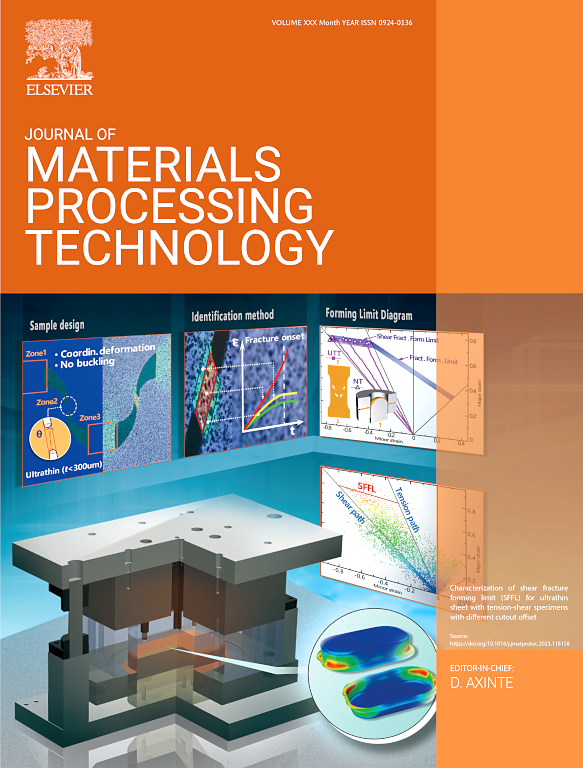脉冲高磁场对铝合金环残余应力的松弛:释放机制和性能评估
IF 6.7
2区 材料科学
Q1 ENGINEERING, INDUSTRIAL
Journal of Materials Processing Technology
Pub Date : 2025-02-17
DOI:10.1016/j.jmatprotec.2025.118778
引用次数: 0
摘要
残余应力通常存在于金属部件中,可能导致结构不稳定和强度降低。因此,有效消除残余应力在制造大型金属部件中是必不可少的。传统的应力消除方法包括能量法和机械法。然而,基于能量的方法耗时且会降低部件强度,而机械方法可能会破坏接触面并导致局部应力集中。本文介绍了一种利用脉冲强磁场消除残余应力的新技术。该方法在环的内表面施加脉冲磁场,产生强烈的非接触洛伦兹力,引发轻微的塑性变形,释放弹性区域的残余应力。值得注意的是,这个过程只需要几毫秒。该研究考察了通过脉冲磁场消除残余应力的机制,并设计了一种大型铝环应力消除装置。通过6061铝合金圆环(直径118 mm)胀形实验初步验证,电磁胀形工艺改善了微变形均匀性,促进位错运动,产生亚晶组织,细化晶粒,从而消除应力。设计了5A06铝合金环(直径717 mm)的大型电磁胀形平台。现场试验表明,1 %的塑性变形消除了高达84.9 %的残余应力,表明应力得到了显著的缓解。最后,比较了不同放电胀形模式下不同表面的应力消除效果,并分析了产生差异的原因。该方法显著提高了大型铝合金环件残余应力消除的效率和效果。本文章由计算机程序翻译,如有差异,请以英文原文为准。
Relaxation of residual stress in aluminum alloy rings by pulsed high magnetic field: Relieving mechanisms and performance evaluation
Residual stress is commonly present in metal components, potentially leading to structural instability and reduced strength. Thus, effective elimination of residual stress is essential in manufacturing large metal components. Traditional methods for stress relief include energy-based and mechanical approaches. However, energy-based methods are time-consuming and can weaken component strength, while mechanical methods may damage contact surfaces and cause localized stress concentrations. This paper introduces a novel technique for relaxing residual stress using pulsed high magnetic fields. The method applies a pulsed magnetic field to the ring’s inner surface, inducing a strong, non-contact Lorentz force that triggers slight plastic deformation, releasing residual stress in the elastic regions. Remarkably, the process takes only a few milliseconds. The study examines the mechanisms behind residual stress relief via pulsed magnetic fields and designs a device for stress elimination in large aluminum rings. Initial validation through bulging experiments on 6061 aluminum alloy rings (118 mm diameter) showed that the electromagnetic bulging process improves micro-deformation uniformity, promotes dislocation motion, generates sub-grain structures, and refines grains, thereby relieving stress. A large-scale electromagnetic bulging platform was then designed for 5A06 aluminum alloy rings (717 mm diameter). In-situ experiments demonstrated that a plastic deformation of 1 % eliminated up to 84.9 % of residual stress, indicating substantial stress relief. Finally, the study compared the effectiveness of stress elimination across different surfaces under various discharge bulging modes and analyzed the reasons for these differences. This method significantly enhances the efficiency and effectiveness of residual stress elimination in large aluminum alloy rings.
求助全文
通过发布文献求助,成功后即可免费获取论文全文。
去求助
来源期刊

Journal of Materials Processing Technology
工程技术-材料科学:综合
CiteScore
12.60
自引率
4.80%
发文量
403
审稿时长
29 days
期刊介绍:
The Journal of Materials Processing Technology covers the processing techniques used in manufacturing components from metals and other materials. The journal aims to publish full research papers of original, significant and rigorous work and so to contribute to increased production efficiency and improved component performance.
Areas of interest to the journal include:
• Casting, forming and machining
• Additive processing and joining technologies
• The evolution of material properties under the specific conditions met in manufacturing processes
• Surface engineering when it relates specifically to a manufacturing process
• Design and behavior of equipment and tools.
 求助内容:
求助内容: 应助结果提醒方式:
应助结果提醒方式:


